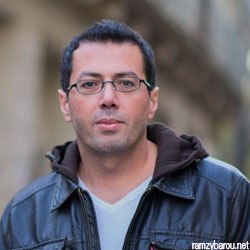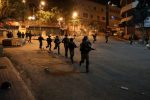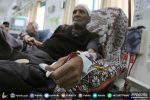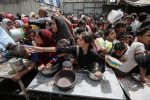Just when Israel and even some Palestinians have started to talk about the Lions’ Den phenomenon in the past tense a large number of fighters belonging to the newly-formed Palestinian group marched through Nablus in the occupied West Bank last week. Unlike the group’s first appearance on 2 September the rally in the Old City on 9 December was significantly larger and better equipped with fighters wearing uniform military fatigues and putting in place tighter security.
“The Den belongs to all of Palestine and believes in the unity of blood struggle and rifles” they declared. This was a reference to the kind of collective resistance that surpasses factional interests.
Needless to say the event was significant. Only two months ago Israeli Defense Minister Benny Gantz sought to undermine the group in terms of numbers and its influence. He estimated that it had just “30 members” and pledged to “get our hands on them… and eliminate them.”
The Palestinian Authority was also active in suppressing the group although using a different approach. Palestinian and Arab media spoke about generous PA offers of jobs and money for Lions’ Den fighters should they agree to put their weapons down.
The Israeli and Palestinian leaderships have both greatly misread the situation. They have assumed wrongly that the Nablus-born movement is a regional and provisional phenomenon that like others in the past can be crushed or bought with ease.
The Lions’ Den however seems to have increased in number and has already branched out to Jenin Al-Khalil (Hebron) Balata and elsewhere. For Israel and even for some Palestinians the Lions’ Den is an unprecedented problem the consequences of which threaten to change the political dynamics in the occupied West Bank completely.
As Lions’ Den insignia now appears in every Palestinian neighborhood throughout the Occupied Territories the group has succeeded in branching out from a specific Nablus neighborhood — Al Qasaba — to become a collective Palestinian experience.
A recent survey conducted by the Palestinian Centre for Policy and Survey Research (PCPSR) demonstrated the above claim in an unmistakable way. The PCPSR poll suggested that 72 per cent of all Palestinians support the creation of more such armed groups in the West Bank. Nearly 60 per cent fear that an armed rebellion risks a direct confrontation with the PA. Seventy-nine per cent reject the call for the fighters to surrender to PA forces and a whopping 87 per cent reject the very idea that the PA has the right to carry out such arrests.
Such statistics attest to the reality on the street. They point to the near complete lack of trust in the PA alongside a significant belief that only armed resistance similar to that in the Gaza Strip is capable of challenging the Israeli occupation.
These notions are driven by empirical evidence: the failure of the financially and politically corrupt PA in advancing Palestinian aspirations in any way for example; Israel’s complete disinterest in any form of peace negotiations; and the growing far-right fascist trend in Israeli society which is linked directly to the daily violence meted out against Palestinians in occupied East Jerusalem and the West Bank.
The UN Mideast Envoy Tor Wennesland reported recently that 2022 is “on course to be the deadliest year for Palestinians in the West Bank since… 2005.” The Palestinian Health Ministry has registered that 167 Palestinians were killed in the West Bank this year alone.
These numbers are likely to increase under the incoming right-wing Israeli Prime Minister Benjamin Netanyahu and his even more extreme far-right coalition. The new government can only remain in power with the support of Bezalel Smotrich from the Religious Zionism Party and Itamar Ben-Gvir from the Otzma Yehudit Party. Ben-Gvir is a notorious extremist and is ironically though not surprisingly slated to become Israel’s new security minister.
However there is more to the looming armed uprising in the West Bank than Israeli violence. Nearly three decades after the signing of the Oslo Accords Palestinians have achieved none of their basic political or legal rights. On the contrary emboldened right-wing politicians in Israel are now speaking of unilateral “soft annexation” of large parts of the West Bank. None of the issues deemed important when the accords were signed in 1993 — the status of occupied Jerusalem refugees borders water etc. — are even on the agenda today.
Since then Israel has invested more in racial laws and racist policies making it the embodiment of an apartheid regime. Major international human rights groups have accepted and reported on the new fully racist apartheid identity of the occupation state.
With total US backing and no international pressure on Israel that is worthy of mention Palestinian society is mobilizing beyond the traditional channels of the past three decades. Despite the admirable work of some Palestinian NGOs the “NGO-ization” of Palestinian society operating on funds largely obtained from Israel’s own western backers has further accentuated class divisions among Palestinians. With Ramallah and a few other urban centers serving as the headquarters of the PA and a long list of NGOs the cities of Jenin and Nablus and their adjacent refugee camps subsist under economic marginalization Israeli violence and political neglect.
Disenchanted by the PA’s failed political model and increasingly impressed by the armed resistance in Gaza an armed rebellion in the West Bank is simply a matter of time.
What differentiates the early signs of another intifada in the West Bank from the 2015 “Jerusalem Intifada” — aka the “Knives Intifada” — is that the latter was a series of individual acts carried out by oppressed West Bank youth while the former is a well-organized grassroots phenomenon with a unique political discourse that appeals to the majority across Palestinian society. Moreover unlike the armed Second Palestinian Intifada (2000-2005) the looming armed uprising is rooted in a popular base not in the PA security forces.
The closest historical reference to this phenomenon is the 1936-39 Palestinian Revolt led by thousands of Palestinian fellahin — peasants — in the countryside of Palestine. The last year of that rebellion witnessed a large split between the fellahin leadership and the city-based political parties. History is thus repeating itself. And like the 1936 Revolt the future of Palestine and the Palestinian Resistance — in fact the very social fabric of Palestinian society — is on the line.
– Ramzy Baroud is a journalist and the Editor of the Palestine Chronicle. He is the author of five books. His latest is ‘These Chains Will Be Broken: Palestinian Stories of Struggle and Defiance in Israeli Prisons’. Baroud is a Non-resident Senior Research Fellow at the Center for Islam and Global Affairs (CIGA) and also at the Afro-Middle East Center (AMEC).












